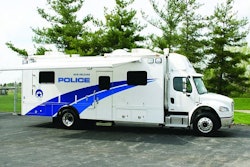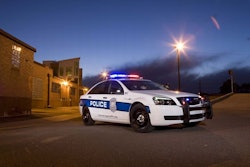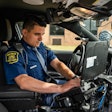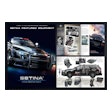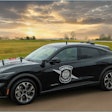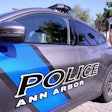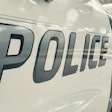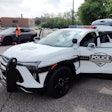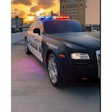Acquiring any big ticket item for a law enforcement agency takes lots of time and lots of money. So when the Indiana Department of Homeland Security had the opportunity to purchase a new mobile command center from Supreme Specialty Vehicles, Response Director Shane A. Booker wanted to do it right the first time. He recruited various people to come up with a combination of features that would meet his agency's needs for a long time to come.
Funding
No government project can go forward without allocated funds in place, so funding is the first step. For most police departments grants are key to funding the purchase of a large item. But since everyone is fighting over the same monies, it's important to submit the best application possible to win a grant. Thoroughness pays off, as does using a good grant writer who can communicate what an agency needs and why.
"A lot of departments have experienced grant writers, but I've seen that they aren't necessarily the operations people, the people that have gone out there," says Booker. "The more you can educate the grant person, the better they can understand your needs, the more likely that the grant will be inclusive of the things that it needs to say to prove that it will greatly enhance capabilities."
The Indiana DHS command vehicle, referred to as an incident response vehicle or IRV, is expected to serve various areas around the state. So the agency researched the number of command vehicles in Indiana and what their capabilities were. It was found that they didn't have high-tech communications and video capabilities. So the DHS sought to fill that need with its new vehicle.
"I think that's another key factor in the grant aspect," says Booker. "If it benefits more than one agency-anyone at the local, state, or federal level-that adds to that justification."
Indiana DHS received a homeland security grant for the planned vehicle, but that didn't mean there wouldn't be other costs involved. Booker says one of the reasons county command vehicles in Indiana don't have more capabilities is because of the sustainment costs involved.
"Another huge factor in the procurement is making sure that we have the money for the satellite components, that we can afford the insurance, and that we can maintain the equipment to ensure that it is in a constant state of readiness so that when we do show up on the scene things are going to work the way that they should," says Booker.
In fact, the vehicle Indiana DHS customized was originally intended as a more regional vehicle. But that district ended up not being able to support the overall cost because of a declining budget and other issues, so the state Department of Homeland Security took responsibility for the cost of the vehicle.
Customization
Since the platform, or vehicle model, had been decided on, Booker needed to come up with a team of people to decide the best way to customize it to Indiana DHS needs, as opposed to the county it had originally been intended for.
"The big thing for us was that we couldn't plan in a vacuum," says Booker. "We had to look at it not only from our perspective-emergency response and incident management-but from our partners' perspective of what they would need."
Booker took great pains to incorporate input from all interested parties. He put together a group of people to tour several completed Supreme Specialty Vehicle models similar to the one Indiana DHS had purchased to get an idea of how they wanted theirs to be customized. Not surprisingly, technology experts were well represented.
"We took three different people from the Indiana Office of Technology, which handles all of our IT needs; one person each from the telecomm, networking, and desktop/hardware side of it," says Booker. "We also took two different communications folks: one from the Indiana Department of Homeland Security and one from the integrated public safety commission, which manages our statewide 800MHz radio system. We took one other person who helps with incident management."
One aspect of the vehicle's design that might seem minor concerned the conference table. When Booker and his team toured a model similar to their own, they noticed there wasn't enough room for people to comfortably access one side of the table. In speaking with Supreme, they decided to add a slide-out to the other side of the vehicle. Not only did this fix the access issue, it also created enough space for two additional work stations.
Booker suggests that agencies looking to procure a mobile command center tour similar vehicles in their area to spot any potential problems such as this while the vehicle is still in the planning stages to avoid disappointment or costly changes down the line.
Advanced Communications
Since providing a central point of communication for an incident is the whole point of a mobile command center, the technology that makes it possible is of paramount importance. If cellular networks were down because of a disaster, the IRV would need another means of voice communication. High on the list of essentials were a satellite system and robust Internet connectivity.
The Indiana Office of Technology installed a wireless access point inside the vehicle and an access point on top of the vehicle's mast camera. "So anywhere we go we train in a wi-fi bubble," says Booker.
That wireless signal has two sides: a closed internal state wireless network and a free public wireless side. Because the network traffic is set up to give priority to the state traffic, Indiana DHS can offer free access to the Internet through its vehicle without compromising its operations or slowing down its network traffic.
Having recently upgraded its Emergency Operations Center with new capabilities such as VoIP telephones with a video option, Indiana DHS also needed its new vehicle to meet the same standards in order to be compatible.
Not everything could be completed by Supreme. But the company worked with Indiana DHS and its partners to install all of the necessary components to meet the agency's specifications.
"Supreme and the Indiana Office of Technology and a company called Net Tech worked to get us a really robust platform to do what we really need to do for disaster and emergency response," says Booker. "There were a few things we wanted to add over time, and Supreme was more than happy to accommodate us and work with us to get the things done that we need."
Security
Another important consideration for a mobile command center is security. The scene of a major incident can become chaotic, and it's difficult to keep track of who's entering the vehicle unless specific measures have been taken.
To ensure that passersby wouldn't stumble upon any sensitive information, no windows were installed in the vehicle. To keep out all but the most necessary personnel, doors were engineered to automatically lock and a passcode is needed to enter from the outside. Additionally, security cameras were installed on all sides of the vehicle.
"We already had a 40-foot mast camera, so one of the things we required one of our technology integrating partners to do was take the mast camera and four security cameras and combine that into one package," says Booker. "That allows us to not only use the video in the command unit, but also to send that video live back to the emergency operations center."
The video is recorded locally in the vehicle where it can be played back instantly and can be kept for up to 10 days. Simultaneously, any video recorded in the vehicle is sent back to the state emergency operations center where it's also recorded. Video files are kept in the EOC for about 30 days.
Quick Response
While the various components and capabilities of a command vehicle are important, they're only useful once the vehicle has both arrived on scene and been set up for full functionality. With this in mind, Indiana DHS set out to increase its response time and flexibility when designing its IRV.
"One thing we really wanted to get out of this vehicle from Supreme was the capability to set up the vehicle very quickly," says Booker.
The agency's previous vehicle, which is still in use for certain incidents, is a trailer that's more than 50 feet long. It's complicated and time-consuming to set up and it's difficult to maneuver, unlike the new IRV from Supreme which is much smaller and has customized axles for a tighter turning radius.
"We're to the point now where we can get it set up in under 10 minutes," says Booker. "That's really important. Not just if an incident site changes or if you're following along and maybe a tornado touches down, but at the same time you have the ability for emergency response to flee from flooding as it goes downstream."
Such response time was put to the test while Indiana DHS was exhibiting its new incident response vehicle on behalf of Supreme Specialty Vehicles at a local tradeshow. Booker received an emergency request for assistance in Indianapolis. Both city and state SWAT teams as well as the FBI were on hand, but they didn't have the resources they needed for the incident. Indiana DHS was able to pack up the vehicle in 10 minutes, drive it from the show to the scene, and set it up in 10 minutes to serve as an incident command center.
"Our IRV is really a great platform for us to respond to incidents quickly," says Booker. "Not only do we have the tools we need, but we also have the tools to help local folks and then to share live video not only back to the EOC, but with other partners via a secure application."
Operational Needs
After spending many years working in emergency response with mobile command centers, Booker had a good idea of how to approach purchasing one for the Indiana Department of Homeland Security. He was happy with Supreme Specialty Vehicles' involvement in the process, as well as the relatively short two months it took for customization decisions to be made and implemented. Especially considering the multiple parties involved and the sophisticated technologies that needed to be installed.
Based on his experiences, Booker has advice for agencies looking to purchase a mobile command vehicle. He recommends looking at other agencies' vehicles and asking them about the features they utilize for different incidents, as well as how they would design the vehicle differently if given the chance.
But the most important requirement is making sure your vehicle will suit your agency's unique issues.
"Try to understand your operational needs and challenges, and what the vehicle can do to help fix those problems," says Booker. "Don't get painted into a box of something that won't, because then it's not going to fulfill your purposes."






